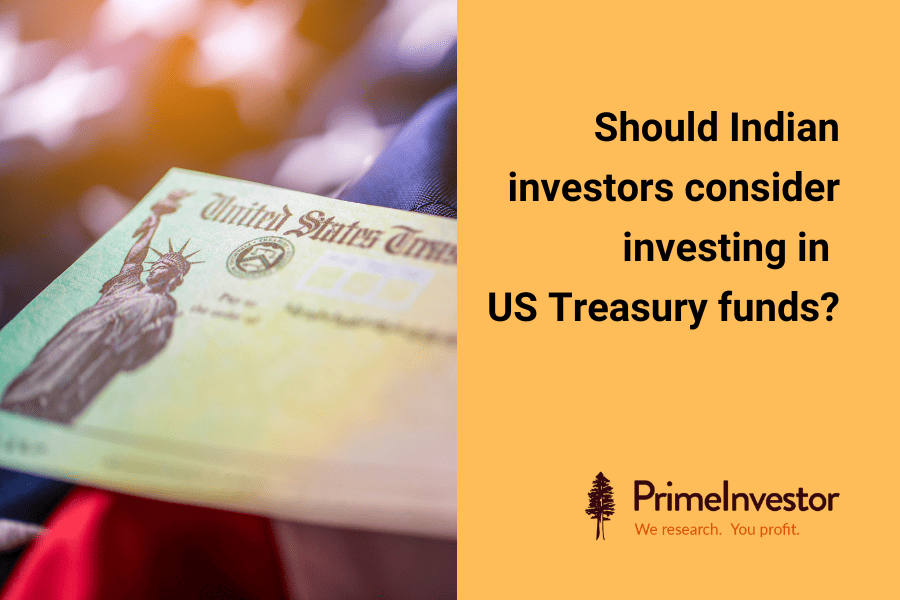Indian investors now have a new option on their international menu – funds investing in US government bonds (also called treasuries). Bandhan Mutual Fund runs a US Treasury Bond 0-1-year Fund of Funds and Aditya Birla Sun Life has a US Treasury 1-3-year and 3-10-year Bond ETFs Fund of Funds.
If funds investing in US stocks and the Nasdaq-100 have done so well in the last 5 years, beating many domestic equity funds, can US treasury funds do the same? Can they beat funds investing in Indian debt?
Some argue that they can. With US treasuries yielding close to 5% now, and the Rupee historically depreciating by about 3-4% a year against the dollar, the argument goes this is a great time to invest in US treasury funds and make an 8-9% return.
We don’t agree with this view. We think that US treasuries make for a risky and unreliable option for Indian investors to get to 8-9%. While it makes sense for Indian investors to have an allocation to US equities in their portfolio, the case for allocating to US treasuries is weak. Here’s why.

Conflicting rate signals
To make decisions on whether it is a good time to invest in any debt category, it is necessary to take a view on the future direction of interest rates. If interest rates in the economy are close to peaking, investing in long-duration debt funds makes sense. If we believe rates can rise further, it is best to avoid long duration debt and stick to short duration.
We have recently made a case for Indian investors to enter a certain category of long duration debt fund because we could reason that interest rates in India are close to their peak in the current cycle. In India, the MPC is trying to strike a trade-off between sustaining economic growth and reining in inflation, while taking its rate hike decisions.
But the direction of US interest rates is quite unclear today, with conflicting signals emerging from the US Fed and the US economy. In the past year, US Fed Chairman Powell has used every opportunity to make hawkish statements about holding rates high, as long as US inflation remains above the Fed’s ultra-conservative target of 2% (the latest print was at 3.4%). He has been talking of hiking the Fed Funds rate until there is clear evidence that the US economy is slowing and shrinking US jobs and incomes (strange but true!). The expectation is that slowing jobs and incomes will act to quell inflation.
However, the US economy is so far defying the Fed’s attempts to forcibly slow it. It has continued to show brisk job additions and high real GDP growth. For the months of September and October 2023, the US reported non-farm payrolls of 1.87 lakh and 3.36 lakh, against forecasts of 1.7 lakh for each month, indicating a strong pace of job creation. Contrary to expectations of a recession, US GDP growth accelerated to 4.9% growth in Q3 FY23. This was despite the Fed hiking its policy rates by a whopping 550 basis points since April 2022, to take it to 5.25-5.5%.
Therefore, we are unable to take the view that the Fed will start to cut rates soon, making this a good time to invest in long-term US treasuries.
In its September meeting, the FOMC (US equivalent of MPC) projected that the Fed Funds Rate would peak out at 5.6% by end-2023 and then decline to 5.1% by 2024. FOMC members also expect inflation to moderate to 2% only in 2026. With US GDP and jobs data after that meeting coming in stronger-than-expected, rate cut hopes are now being pushed back to the end of 2024. This makes the call to invest in long-dated US treasuries a dicey one.
Problematic government finances
While the Fed is threatening to keep rates ‘high for longer’, the problematic state of US government finances is putting upward pressure on market interest rates. With the Fed’s rate hiking spree, the yield on the 10-year US treasury has spiked from under 1% in July 2020 to about 4.8% now. It has recently, been flirting with its 16-year high of 5%.
Of late, US market yields have been rising even without any further rate hikes by the Fed, because markets are worried about the US government’s insatiable appetite for borrowings and the strain this will put on its ability to service its debt.
Fiscal deficit numbers that shoot up over 5% and run into trillions of dollar are not new for the US economy. The country ran up fiscal deficits of over a trillion dollars every year between 2009 and 2012, as it rescued US financial entities from the global financial crisis. However, as those deficits were accompanied by sharp declines in interest rates to near-zero levels, the government was able to keep its interest outlays within man ageable levels.
With US Fed rapidly reversing its low-rate policies in the last couple of years, the US government’s interest outgo has been shooting through the roof. The prospect that the US government will have to refinance and service trillion-dollar deficits at interest rates of 5% plus, has had fiscal watchdogs sounding the alarm bells. This has been spooking the markets and causing investors to demand much higher yields from US treasuries, despite their global safe haven status.
Given the state of US government finances, it is difficult to say what will put a halt to this rise in market yields. It must also be noted that the US Fed is reversing its low-rate policies after a 14-year gap, so we are in uncharted territory. Before the low-rate regime kicked in, US 10-year treasuries used to trade in the 4-7% range. But that was at much lower levels of US government debt.
High return volatility
All these factors make longer-tenure US treasuries a risky proposition today. But what about shorter term US treasuries, upto 1 year? Could you still invest there to capitalise on the current 5.4% yield? The problem is that this is a highly volatile instrument. Investors who park money in short term treasuries usually do so for capital safety and stability of returns. But US treasuries have been highly volatile in the last couple of years, owing to the pull and push of the various factors cited above: Fed actions, US economic outlook, jobs data, inflation prints etc. In the last three years, the US 1-treasury yield has swung between 0.03% and 5.46%.
In comparison, the Indian government’s treasury bills seem to offer a much more stable proposition for Indian investors looking for a short-term parking ground, at a higher yield of 7%. The Indian rate outlook is far less clouded than that in the US. The Indian government has been shrinking its deficit in a growing economy. RBI has been careful to take measured rate hikes that won’t upset growth. Volatile bouts of food inflation have been ignored by it. Yields on local treasury bills have been less volatile than those in the US, trading between 3.3% and 7.3% in the last three years.
Unpredictable Rupee gains
A popular argument for Indian investors to buy US treasury funds is that such funds will help you gain from Rupee depreciation against the US dollar. It is true that the Indian Rupee has depreciated steadily against the dollar in the last three decades, with the rate of depreciation averaging out to about 3-4% on an annualised basis. But this depreciation has been far from uniform from year-to-year. There have been years like 2008 or 2013 when the Rupee has slid by 11-19% against the US dollar. But there have also been years like 2009 and 2017 where the Rupee has appreciated by 5-6% against the dollar.
When you invest in US treasuries with a short horizon of less than 3 years in mind, there’s no guarantee that the Rupee will depreciate in those years. Even if it does, there’s no certainty about a 3-4% depreciation. In fact, the forex element will add one more layer of volatility to your returns from US treasury funds.
Limited use case
Having said all this, the only use case we see for Indians to own US treasury funds is to fund expenses that you expect incur in US dollars in the near future (for relatives stationed in the US, children studying there, travel etc). Investors having a dollar expenditure may like to hedge against Rupee depreciation by owning assets denominated in dollars. Equities do not fit the bill here given the significant risk of losses in the short run. Short-term US treasury funds sticking to 0-1 year treasuries may offer a better option. Such investments also help you avoid the 20% TCS on LRS remittances.
As to international funds investing in US equities, we remain positive on them, though they do carry the near-term risk of a significant correction due to the risks to the US economy from rate hikes. The US stock market offers Indian investors the opportunity to participate in the growth of some of the most innovative, disruptive and fast-growing companies in the world, and that is not going to change anytime soon. This previous article explains why we recommend that you allocate to US equity funds.








10 thoughts on “Should Indian investors consider investing in US Treasury funds?”
Hello Madam,
Excellent article!!
I have already invested in long term gilt(constant maturity fund) and doing SIP as well. It is clear to me that I can continue to invest till 10yr bond yield stays 7% and above.
and, Yes, our treasury yields are also around 7% and looks attractive for short term as well. 🙂
Thank you, Vijay
Yes that’s the right strategy! Thank you
Excellent article Aarati ji
Every aspect is crystal clear to me now.
Thank you! Enjoyed writing it!
Well articulated ! In fact there are voices that feel that the Dollar index cannot remain elevated and has to give up some gains. If that happens, in the near term we may even see 1-2 yrs of INR being flat or even mildly positive.
These instruments seem to add more to the glamour quotient rather than make any meaningful
Investment sense !
Absolutely! Yes agree Rupee depreciation is no longer a given.
Please clarify how this avoids the TCS via LRS route. I may hedge the currency for now but eventually will need to send money abroad using the bank and pay the TCS.
You can avoid remitting or investing a large lumpsum overseas to hedge against Rupee depreciation and instead remit only actual expenses which may be below the LRS limit of Rs 7 lakh
Hello Madam,
Thank you so much to cover this subject in detail. It really took out some of the myths and preconceived notion which I had.
Thank you!
Comments are closed.